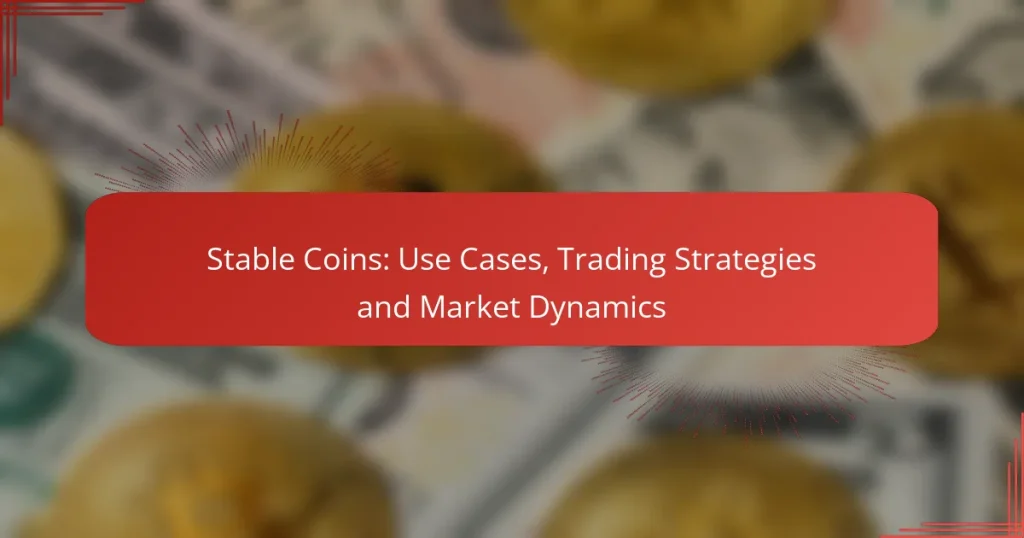Cryptocurrency stable coins are digital currencies designed to maintain a stable value, often pegged to fiat currencies like the US dollar. Popular options in the US include Tether (USDT), USD Coin (USDC), and Binance USD (BUSD), which help traders and investors navigate the volatility of the crypto market. Their stability makes them practical for transactions and as a reliable store of value.
Stable Coins: Investment Goals, Risk Tolerance and Liquidity
Stable Coins: Fee Structures, Hidden Costs and Value
Stable Coins: Use Cases, Trading Strategies and Market Dynamics
Tether vs USDC: Which Stable Coin is Better and When to Use
DAI: Performance, Use Cases and Long-Term Holding
What are the best cryptocurrency stable coins in the US?
The best cryptocurrency stable coins in the US include Tether (USDT), USD Coin (USDC), TrueUSD (TUSD), Pax Dollar (USDP), and Binance USD (BUSD). These stable coins are designed to maintain a stable value, typically pegged to the US dollar, making them popular choices for traders and investors looking to minimize volatility.
Tether (USDT)
Tether (USDT) is one of the most widely used stable coins, with a market capitalization that often leads the sector. It is pegged 1:1 to the US dollar, meaning for every USDT issued, there is an equivalent dollar held in reserve. This makes it a go-to option for many traders seeking liquidity.
However, Tether has faced scrutiny regarding its reserve transparency. Users should be aware of the ongoing debates about whether Tether has sufficient reserves to back all issued tokens. It’s advisable to stay informed about Tether’s financial disclosures to assess its reliability.
USD Coin (USDC)
USD Coin (USDC) is another popular stable coin, known for its regulatory compliance and transparency. It is also pegged to the US dollar at a 1:1 ratio and is backed by reserves that are regularly audited by third parties. This makes USDC a preferred choice for those prioritizing trust and security.
USDC is widely accepted across various platforms, making it easy to use for transactions and trading. Users should consider its growing adoption in decentralized finance (DeFi) applications, which can enhance its utility beyond simple transactions.
TrueUSD (TUSD)
TrueUSD (TUSD) is a stable coin that emphasizes transparency and legal protections. Like USDC and USDT, TUSD is pegged to the US dollar and is backed by reserves held in escrow accounts. Regular attestations ensure that the amount of TUSD in circulation is fully backed.
Investors should note that TrueUSD is often used in trading and lending platforms, providing liquidity options. Its focus on regulatory compliance may appeal to users looking for a stable coin with a strong legal framework.
Pax Dollar (USDP)
Pax Dollar (USDP), formerly known as Paxos Standard, is a regulated stable coin that is also pegged to the US dollar. It is issued by Paxos Trust Company, which is regulated by the New York State Department of Financial Services. This regulatory oversight adds a layer of trust for users.
USDP is designed for seamless integration with various financial services, including trading and payment solutions. Users should consider its regulatory backing as a significant advantage when choosing a stable coin for transactions.
Binance USD (BUSD)
Binance USD (BUSD) is a stable coin issued by Binance in partnership with Paxos. It is pegged to the US dollar and is regulated, providing users with a secure option for trading on the Binance platform and beyond. BUSD is also backed by reserves that are regularly audited.
For users engaged in trading on Binance, BUSD offers a convenient way to manage funds without converting to fiat. However, it’s essential to consider the potential limitations of using a stable coin that is closely tied to a specific exchange.
How do cryptocurrency stable coins work?
Cryptocurrency stable coins are digital currencies designed to maintain a stable value by [censured] them to a reserve of assets, typically fiat currencies or other cryptocurrencies. This stability makes them useful for transactions and as a store of value in the volatile crypto market.
Fiat-backed stable coins
Fiat-backed stable coins are pegged to traditional currencies like the US Dollar or Euro, with reserves held in bank accounts or other secure assets. For example, a stable coin like Tether (USDT) aims to maintain a 1:1 value with the US Dollar, meaning for every USDT issued, there is an equivalent dollar held in reserve.
When using fiat-backed stable coins, it’s crucial to verify the issuer’s transparency and reserve audits. Some common pitfalls include relying on coins that lack regular audits or have unclear backing, which can lead to unexpected volatility.
Crypto-backed stable coins
Crypto-backed stable coins are secured by other cryptocurrencies, often over-collateralized to account for price fluctuations. For instance, DAI is a stable coin backed by Ethereum, where users lock up ETH in a smart contract to mint DAI, maintaining its peg through automated mechanisms.
Investors should be aware of the risks associated with crypto-backed stable coins, including potential liquidation of collateral during market downturns. It’s advisable to understand the collateralization ratios and the mechanisms in place to maintain stability.
Algorithmic stable coins
Algorithmic stable coins use algorithms and smart contracts to control supply and demand, adjusting the coin’s supply based on market conditions to maintain its peg. Unlike fiat or crypto-backed coins, they do not rely on physical reserves, which can lead to higher risks and volatility.
When considering algorithmic stable coins, be cautious of their reliance on market confidence and the effectiveness of their algorithms. Historical examples show that some have failed to maintain their pegs during market stress, leading to significant losses for holders.
What are the advantages of using stable coins?
Stable coins offer several advantages, primarily their ability to maintain a stable value relative to traditional currencies. This stability makes them a practical choice for transactions and investments in the volatile cryptocurrency market.
Price stability
Price stability is one of the most significant benefits of stable coins. Unlike traditional cryptocurrencies, which can experience dramatic price swings, stable coins are pegged to stable assets, typically fiat currencies like the US dollar or the euro. This [censured] helps users avoid the risks associated with price fluctuations.
For example, a stable coin pegged to the US dollar aims to maintain a value of approximately $1. This predictability allows businesses and individuals to use stable coins for everyday transactions without worrying about sudden changes in value.
Fast transactions
Stable coins enable fast transactions, often settling in seconds or minutes compared to traditional banking systems that may take days. This speed is particularly beneficial for cross-border payments, where stable coins can bypass lengthy processing times associated with currency conversions and bank transfers.
For instance, sending stable coins can be completed in a matter of minutes, allowing for quick settlements in international trade or remittances without the delays typical of conventional methods.
Lower volatility
Lower volatility is a key feature of stable coins, making them attractive for both investors and users. Since stable coins are designed to maintain a consistent value, they are less susceptible to market fluctuations compared to other cryptocurrencies. This characteristic allows users to hold their assets without the fear of significant devaluation.
Moreover, lower volatility encourages more people to adopt stable coins for transactions and savings, as they provide a reliable store of value. This stability can be especially appealing in regions with unstable currencies or economic uncertainty.
What are the risks associated with stable coins?
Stable coins carry several risks that can impact their reliability and value. Understanding these risks is crucial for investors and users, as they can affect the stability that these coins aim to provide.
Regulatory risks
Regulatory risks arise from the evolving legal landscape surrounding cryptocurrencies. Governments may impose new regulations that could affect the operation and acceptance of stable coins, potentially leading to restrictions or bans in certain jurisdictions.
For instance, a country might classify stable coins as securities, requiring issuers to comply with strict regulations. This could limit their availability and usability, impacting their market value and user trust.
Counterparty risks
Counterparty risks refer to the potential failure of the entities backing the stable coin, such as banks or financial institutions. If these entities face insolvency or operational issues, the value of the stable coin could be jeopardized.
For example, if a stable coin is pegged to a fiat currency and the issuer does not have sufficient reserves to back it, users may find themselves holding a coin that is no longer stable. It’s essential to evaluate the credibility and financial health of the backing institutions.
Market risks
Market risks involve fluctuations in demand and supply that can affect the price stability of stable coins. Even though they are designed to maintain a stable value, external market pressures can lead to temporary deviations from their pegged value.
For instance, during periods of high volatility in the cryptocurrency market, stable coins may experience liquidity issues, making it difficult for users to exchange them at their intended value. Monitoring market conditions and trading volumes can help mitigate these risks.
How to choose the right stable coin?
Choosing the right stable coin involves evaluating its backing assets, liquidity, and intended use case. Each factor plays a crucial role in determining the stability and usability of the coin in various transactions.
Backing assets
Stable coins can be backed by various assets, including fiat currencies, commodities, or cryptocurrencies. Fiat-backed stable coins, like USDT or USDC, are pegged to the US dollar, providing a stable value. In contrast, crypto-backed stable coins, such as DAI, use a basket of cryptocurrencies as collateral, which can introduce volatility.
When selecting a stable coin, consider the type of backing and the transparency of the reserves. Look for coins that provide regular audits or proof of reserves to ensure that they maintain their peg effectively.
Liquidity
Liquidity refers to how easily a stable coin can be bought or sold without significantly affecting its price. High liquidity is essential for trading and transferring value efficiently. Coins like USDT and USDC typically have high liquidity due to their widespread adoption across exchanges.
To assess liquidity, check trading volumes on major exchanges and the number of trading pairs available. A stable coin with low liquidity may result in higher slippage and difficulty in executing trades at desired prices.
Use case
Different stable coins serve various purposes, such as trading, remittances, or as a store of value. For example, if you are looking to trade frequently, a highly liquid stable coin like USDT may be preferable. Conversely, if you want to hold a stable asset for long-term savings, a fiat-backed coin with strong regulatory compliance may be more suitable.
Consider your specific needs and the environments in which you plan to use the stable coin. Evaluate factors like transaction fees, speed, and acceptance by merchants or platforms to ensure it aligns with your objectives.
What are the tax implications of using stable coins in the US?
Using stable coins in the US can have significant tax implications, primarily related to capital gains and income tax. Transactions involving stable coins are treated similarly to other cryptocurrencies, meaning any gains or losses must be reported to the IRS.
Capital gains tax
Capital gains tax applies when you sell or exchange stable coins for a profit. If the value of the stable coin increases from the time of acquisition to the time of sale, the profit is subject to taxation. The rate can vary based on how long you held the asset—short-term gains (held for one year or less) are taxed at ordinary income rates, while long-term gains (held for over a year) benefit from lower tax rates.
For example, if you bought a stable coin for $1 and later sold it for $1.10, you would owe capital gains tax on the $0.10 profit. It’s crucial to keep accurate records of your transactions to calculate gains or losses accurately.
To minimize your tax burden, consider strategies such as tax-loss harvesting, where you sell assets at a loss to offset gains. Always consult a tax professional for personalized advice, especially as regulations can change frequently.






